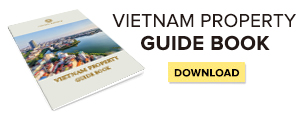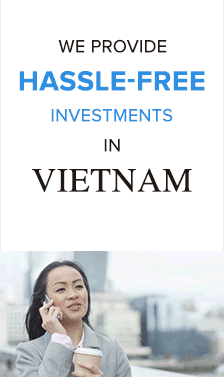HO CHI MINH CITY PROPERTY INVESTMENT SEMINAR
Ho Chi Minh City is the center of the rapid development and economic growth of Vietnam. As overseas investors flock to the city, its financial district, CBD, is expanding rapidly into its neighbor of District 4. The continuous commercial and residential developments, and District 4’s upcoming mega renewal plan, will soon have the property value of the district soaring when expats and a rising middle class inhabit the area. The past weekend, Golden Emperor Properties, in partnership with Singaporean CapitaLand (major shareholder, Singapore government through Temasek Holdings Private Limited), hosted a Ho Chi Minh City Property Investment seminar, where the latest project De La Sol, with an attractive rental yield, was launched with astonishing success.
Photo Above: Managing Director of Golden Emperor Properties, Mr. Terence Chan, facilitates the seminar and provides insights to the city’s property market trend.
Photo Above: The seminar and the launch of De La Sol, was an astonishing success supported by a large group of investors.
VIETNAM ATTRACTS MORE THAN US$8 BILLION FDI IN FOUR MONTHS
More than US$8 billion of foreign direct investment (FDI) capital was registered for investment in Vietnam in the first four months of this year, equivalent to 76.1% of the same period in 2017, according to an announcement by the Foreign Investment Agency (FIA), under the Ministry of Planning and Investment.
In the four-month period, the FDI sector posted a total export revenue (including crude oil) of US$53.48 billion, an increase of 18.9% over the corresponding period in 2017, accounting for 72.5% of Vietnam’s total export revenue.
Meanwhile, the total import revenue of the FDI sector was estimated at US$42.31 billion, up 9.3% over the same period of 2017, which accounts for nearly 60.1% of Vietnam’s total import revenue.
Meanwhile, the total import revenue of the FDI sector was estimated at US$42.31 billion, up 9.3% over the same period of 2017, which accounts for nearly 60.1% of Vietnam’s total import revenue.
In the January-April period, 883 FDI projects were licensed with a total registered capital of US$3.55 billion, equivalent to 76.1% of the same period last year, while 303 currently operating projects registered to expand their capital, with the total supplemented capital amounting to US$2.24 billion, equivalent to 51.5% of the same period in 2017.
In the first four months of this year, foreign investors have spent US$2.26 billion purchasing equity and contributing capital to projects, up 67% over the same period last year.
Investors from 82 countries and territories have invested in Vietnam, with the Republic of Korea (RoK) ranking first in terms of investment capital on US$2.32 billion, accounting for 28.7% of total foreign investment in Vietnam. It was followed by Japan and Singapore.
source: Nhan Dan
Hai Phong International Container Terminal Opens
Looks Forward to Regional Economic Growth
Hai Phong City has become the city in Vietnam with the strongest inflow of foreign direct investment (FDI). Besides the city’s partnership with international corporations, the city is keen to establish partnerships with private sectors in the ASEAN market. Saigon Newport Co, Mitsui OSK Lines Ltd, Itochu Group and Wan Hai Lines Ltd held an opening ceremony earlier this month for the opening of the Hai Phong International Container Terminal (HICT).
HICT is Northern Vietnam’s first large scale container terminal with the ability to handle container-ships of 14,000 twenty-foot-equivalent units (ETU). After a 2-year long construction period to build a sea port 16 feet deep into the coastline, the terminal will be Hai Phong’s and Vietnam’s major trade hub linking Asia, China, Europe and North America.
Additionally, Dinh Vu, located at the Southeastern coastline of Hai Phong, will undergo construction for its second industrial district development, which will largely focus on providing land for foreign manufacturers. Developers wish to attract more foreign manufacturers to join the industry at Hai Phong. Dinh Vu is presently the largest manufacturing district in Vietnam with an area of 2,000 acres. The Hanoi-Hai Phong Freeway, Cat Bi International Airport, Hai Phong- Ha Long Freeway, and infrastructure initiatives along the coastline will propel Hai Phong’s upcoming developments as an international container port. The establishment of the HCIT will be able to decrease the exporting costs for manufacturers and at the same time increase Vietnam’s lead in competition with other economies, bringing in new opportunities and economic growth to Vietnam.
Hai Phong City has already established a number of partnerships within the ASEAN community to provide room for potential businesses in economy, cultural and societal movements. Hai Phong benefits from its sea-port location, an exotic culture and proximity to Ha Long Bay, all of which may contribute to its future economic growth.
Source: Now News, China Times
Thai businesses put strong pressure on domestic firms
The Vietnamese market has drawn many Thai enterprises who are engaging in the market through different methods, which has put pressure on local firms. One of the advantages Thai businesses have is that Vietnamese customers have long been fond of their products.
Thai enterprises have made good preparation for their penetration into the Vietnamese market by holding fairs to introduce their goods and food.
Competition from Thai products in the domestic market has grown fiercer. In the first three months of 2018, Vietnam imported nearly 2.6 billion USD worth of goods from Thailand, including 146 million USD worth of vegetable and fruits. Meanwhile, Vietnam only exported 1.3 billion USD worth of goods to Thailand.
Last year, Thailand was the largest trade partner of Vietnam among ASEAN countries with two-way trade reaching 15.11 billion USD, accounting for 30.5 percent of total trade revenue between Vietnam and ASEAN countries.
Recently, Vietnamese firms have made many efforts to export more products to Thailand, including “thieu” lychees.
According to the Ministry of Industry and Trade, although Vietnam’s exports to Thailand have increased in recent years, Thailand still has a trade surplus.
Along with promoting trade, Thai enterprises have set up production facilities in Vietnam. According to the Foreign Investment Agency under the Ministry of Planning and Investment, Thailand is the 10th largest foreign investor in Vietnam with 492 valid projects worth 9.48 billion USD.
In the first four months of 2018, Thailand climbed to ninth position, while Thai investment ranked fourth at 204 million USD.
Many big Thai players have conducted merger and acquisition deals with Vietnamese firms, leading to a concern that many Vietnamese brands will belong to Thai firms.
Specifically, ThaiBev, run by Thailand’s TCC Holdings, spent nearly 4.8 billion USD buying shares of the Sabeco company. Through F&N Bev Manufacturing and F&N Dairy Investment, the TCC Holdings bought a large number of Vinamilk’s share in the stock market. At the same time, another subsidiary of TCC Holdings, Berli Jucker, also acquired Metro Cash and Carry VN from Metro Group of Germany.
Another Thai power, the Central Group Thailand has expanded its business in Vietnam considerably in the last three years. According to the Central Group Vietnam, the firm owns 230 trade centres in Vietnam with big names such as Big C, Nguyen Kim and Lan Chi Mart, as well as two online retail channels.
Along with consumer goods, Thai businesses are present in other sectors such as construction material, thermal power and animal feed.
Source: Vietnam+
The Vietnamese Secret
Yellow Rice Paddies & Meandering Rivers of Ninh Binh
Lushy green rice paddy fields ripe and turn lucratively into fields of golden yellow every year in May in Ninh Binh, Vietnam. Nicknamed the ‘Ha Long Bay on Land,’ Ninh Binh is absolutely breathtaking. The province stretches across the mountainous valley 90 kilometers south of Vietnam’s capital, Hanoi.
Ninh Binh is a Vietnamese secret and boasts some of the most majestic views in the country. Home to thousands of limestone formations and meandering rivers through rice paddy fields, globe trotters consider it the most picturesque province in the country, topping Ha Long Bay and the country’s beach scenery in the south. There are temples, lakes, caves and authentic towns to visit with hiking treks, bamboo boat ride and bike rides around the region to offer its visitors a glimpse into the ever-dynamic landscapes and the rural lifestyle of this countryside.
At the northern tip of Ninh Binh province, is Hoa Lu, the last reminisce of Vietnam’s ancient capital. The village is marked by a row of orange rooftops along the river and ruined relics from the past. Rugged temple architecture lays in the foreground with grottoes in the back. The valley celebrated its 1050th birthday at the end of April with its Hoa Lu Festival, a water possession festival where locals dance on the streets in traditional clothing and perform a series of unicorn dance. Besides visiting Ninh Binh during its famous festivals, the best way to experience Vietnamese religious culture is a visit to Trang An, famous for a central temple built on an island in an emerald color lake. The site is deemed as one of the best UNESCO sites in Vietnam, best explored by boats across its serene water.
Twenty minutes drive, south of Trang An, down a sleepy and resting path between the rice paddies, is the famous Mua Cave. The cave seems merely just another hilly walk until you reach its top. Landmarked by a 6-storey pagoda, the mountain top offers a panoramic view of Ninh Binh and an impressive birds-eye-view of the gold, ripening rice paddy fields. Dragons which encircle the mountain, will guide you to the peak through its caves and limestone overhangs.
The province hosts more landmarks between the rugged mountains and calm rivers. Bich Dong Pagoda is secretively hidden among the rain-forest on a rocky island with tall mountains captured in the background. The Thung Nham Bird Garden and the Van Long Nature Reserve is a painted canvas where wildlife is found among a green space of trees, wetlands and reflective lakes. The exotic scenery is a harmonious combination between the natural world and ancient architecture. One thousand and fifty years ago when Ninh Binh was discovered, the waters were still. One thousand and fifty years from now, Ninh Binh’s panorama will still be poetic as it always has been.


























